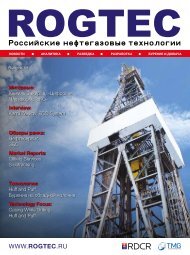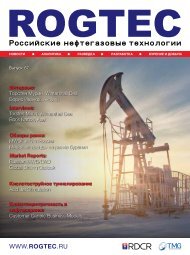ROGTEC Magazine Issue 61
Russian Oli & Gas Magazine
Russian Oli & Gas Magazine
You also want an ePaper? Increase the reach of your titles
YUMPU automatically turns print PDFs into web optimized ePapers that Google loves.
STIMULATION
учитывающий аспекты геолого-геомеханического
строения пласта и технологических параметров
воздействия. В настоящее время одним из основных
подходов к разработке таких нетрадиционных
объектов, как баженовская свита, является создание
«искусственного коллектора», или стимулированного
объема пласта (SRV), представляющего собой
разветвленную сеть трещин, которая позволяет
дренировать значительную часть пласта. В
данной работе рассмотрен комплексный подход
к проектированию, моделированию и проведению
многостайного гидроразрыва пласта (МГРП) в
условиях низкопроницаемого трещиноватого
коллектора – баженовской свиты, учитывающий как
геолого-геомеханические особенности объекта, так
и технологические параметры проведения операций
МГРП. В результате применения данного подхода
разработан и внедрен план выполнения МГРП,
позволивший увеличить стартовый дебит нефти и
накопленную добычу в сравнении с аналогичными
параметрами ранее пробуренных скважин
Подготовка геомеханической модели
Для пластов баженовской свиты характерны наличие
локальных дизъюнктивных нарушений, естественная
трещиноватость, а также неоднородное
напряженно-деформированное состояние.
Следовательно, для качественного моделирования
МГРП в горизонтальной скважине (ГС) с учетом
формирования разветвленной сети трещин сначала
необходимо построить геолого-геомеханическую
3D модель пласта, провести оценку дизъюнктивных
нарушений, построить модель естественной
трещиноватости в районе проектируемой скважины,
а также 1D геомеханическую модель пласта
для точек инициации трещин – стадий МГРП.
1D геомеханическая модель, подготавливаемая
для каждой стадии МГРП, представляет собой
вертикальный разрез целевого и перекрывающих
пластов с определением основных геомеханических
параметров: модуля Юнга, коэффициента Пуассона,
минимального горизонтального напряжения и
др. Результатом выполненного в коммерческом
программном обеспечении расчета инверсионной
модели напряжений являются карты плотности, угла
падения и простирания трещин каждого типа: сдвига,
растяжения, сжатия. При помощи программного
комплекса (ПК) «РОСТ МГРП» осуществляется
построение двумерной модели дискретной
сети трещин DFN (Discret Fracture Network) для
трещин каждого типа в каждой расчетной ячейке
области моделирования. Число трещин в ячейке
нормируется по минимальному и максимальному
значениям плотности их распределения, полученной
в результате расчета инверсионной модели
напряжений. Итогом построения DFN модели
the geological and geomechanical seam structure and
the process-dependent parameters of the formation
stimulation. The Bazhenov Suite deposits have been
developed in horizontal wells with the use of multistage
hydraulic fracturing techniques. This being said,
some complex reservoir structures of the Bazhenov
Suite, as well as a high heterogeneity of its properties,
both along the cross-section and within the whole area
of the license blocks, make it impossible to create a
universal approach for commercial oil production. This
is also due to the fact that a small number of horizontal
wells successfully operated with the use of multi-stage
hydraulic fracturing could not provide a sufficient amount
of statistical data about the outcomes of the performed
multi-stage hydraulic fracturing operations. At present,
one of the basic approaches to the development of
such non-traditional targests, as the Bazhenov Suite, is
to create an “artificial reservoir” or stimulated reservoir
volume (SRV), which is an extensive network of fissures,
making it possible to produce from a considerable part
of a reservoir. Due to the significant differences of the
Bazhenov Suite from a conventional reservoir (extremely
low matrix permeability, natural fracturing, low anisotropy
of rock stresses, etc.) it became necessary to make a
hydraulic fracturing simulator which would enable the
simulation of both planar fissures, and an extensive
network. The Russia-made software system “ROST
MGRP” (Calculation of the Optimal Fracturing System)
has used as a simulator. The developed software product
provides a way of simulating a multi-stage hydraulic
fracturing with a glance to forming both stimulated
reservoir volume, and single planar fissures. The given
article presents a comprehensive approach to design,
simulation and execution of hydraulic fracturing jobs in
the conditions of a low permeable fractured reservoir,
i.e. the Bazhenov Suite, taking into account both the
geological and geomechanical properties of the target,
and the multi-stage hydraulic fracturing job parameters.
This approach resulted in an elaboration and the
introduction of a plan for the execution of multi-stage
hydraulic fracturing jobs, which made it possible to
enhance the initial flow rate and cumulative production,
compared with similar parameters of the previously
drilled wells.
Development of the Geomechanical Model
The Bazhenov Suite reservoirs are featured with
local disjunctive faults, natural fracturing, as well as
heterogeneous strain-stress states. Consequently, to
have a quality simulation of a multi-stage hydraulic
fracturing job in a horizontal well, with a glance to
forming an extensive network of fissures, it is first
necessary to build a geological and geomechanical
3D model of a formation, taking an assessment of
disjunctive faults, building a model of natural fracturing
in the area of a projected well, as well as building a
www.rogtecmagazine.com
ROGTEC
39















